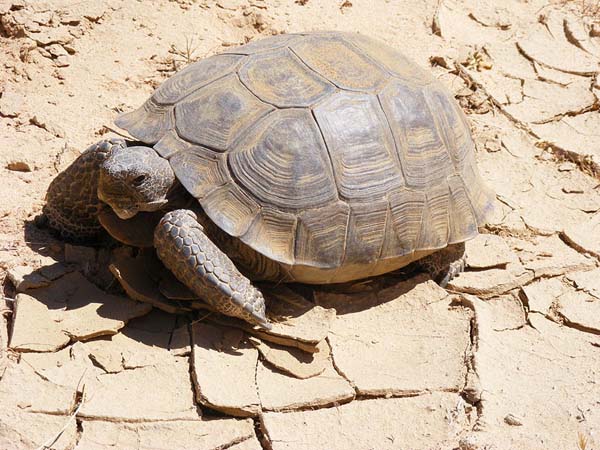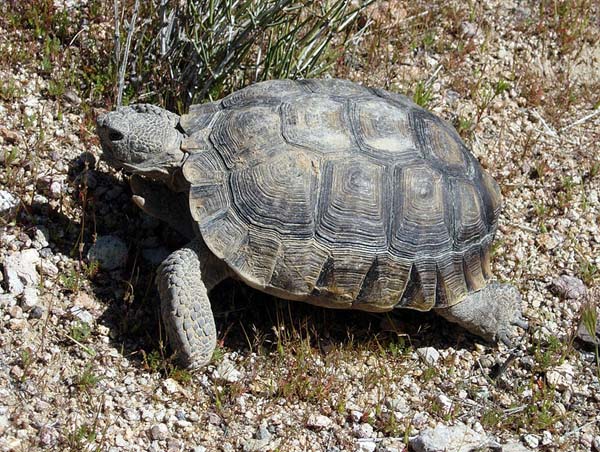Wildlife North America . com North American Animals - mamals, birds, reptiles, insects |
Desert Tortoise (Gopherus agassizii)
Desert Tortoise, photographed in the Mojave desert. Photograph by Tigerhawkvok. Some rights reserved. (view image details) 
Desert Tortoise in Rainbow Basin near Barstow, California. Photograph by Mark A. Wilson. License: Public Domain. (view image details)
DESERT TORTOISE FACTS
DescriptionThe Desert Tortoise is a terrestrial tortoise with a high-domed greenish-tan to dark brown carapace. The front legs have heavy claws and are flattened for digging. The back legs are stumpy. Males are slightly larger than females. Male tortoises have a concave plastron, while females have a flat plastron. The scutes often have brown, orange-brown, or yellowish centers with grooved concentric rings. The underside (plastron) is yellowish with brown along the scute edges. The head is small and rounded and brownish or reddish-tan, with a greenish-yellow eye. The tail is of short. Skin on the legs is brownish, and the neck skin is yellowish. Young tortoises are dull yellow to light brown with dark borders around the scutes. Other Names California Desert Tortoise Size Length 25cm - 36 cm. Weight 4–7 kg. Environment lives in sandy flats and rocky foothills of the desert where it spends most of its time in underground burrows to escape the heat. Food The desert tortoise is a herbivore. It feeds on grasses, herbaceous plants, cacti fruit and flowers. Breeding The Desert Tortoise nests from May to July. They lay clutches of 1-12 (usually 4-8) hard-shelled elliptical eggs in a funnel-shaped nest near the opening of a burrow. The young turtles hatch after 90-120 days. Up to 3 clutches may be laid in a year. The eggs hatch from mid August to October. Desert Tortoises can live to 80-100 years old. Range The Desert Tortoise is found in the Mojave desert and Sonoran desert of the south western United States and northern Mexico. Ranges from Southern Nevada, south west Utah, south eastern California, southern Arizona, to northern Sinaloa Mexico. Conservation Status The conservation status in the 2004 IUCN Red List of Threatened Animals is "vulnerable". Classification
Relatives in same Genus Texas Tortoise (G. berlandieri) Bolson Tortoise (G. flavomarginatus) Gopher Tortoise (G. polyphemus) Home | Mammals | Reptiles | Birds | Insects | Privacy Policy | Disclaimer | Contact Us |